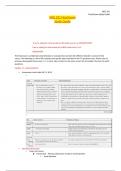Exam (elaborations)
NSG 331 Final Exam Study Guide
- Course
- Institution
NSG 331 Final Exam Study Guide NSG 331 Final Exam Study Guide If we’re asking for what would you DO make sure it’s an INTERVENTION If we’re asking for what would you CHECK make sure it’s an ASSESSMENT The final exam is considered comprehensive in concepts that overar...
[Show more]



